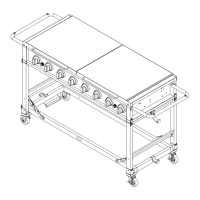
Do you have a question about the Bakers & Chefs mev808alp and is the answer not in the manual?
| Brand | Bakers & Chefs |
|---|---|
| Model | mev808alp |
| Category | Grill |
| Language | English |
Key safety precautions for grill operation, including distance from walls and combustible objects.
Steps to take if you smell gas, including shutting off gas and extinguishing flames.
Prohibits storing flammable liquids near the grill and advises hose inspection and replacement.
Information on chemicals causing harm and warnings against certain fuels or neglecting maintenance.
Instructions to clean burner tubes to prevent flashback fires and ensure safe operation.
Lists required tools, need for assistance, and requirements for local and national gas codes.
Steps for assembling the grill cart, including unfolding legs and straightening the frame bracket.
Instructions for attaching tank holders to the cart and casters to the legs securely.
Steps for installing lid handles and bowl handles using specified screws.
Procedure for lifting and positioning the grill bowl onto the cart and locking latches.
Instructions for positioning grease receptacles and installing the grease tray for safety.
Steps to unscrew the ignitor cap, insert AA battery, and re-tighten the cap.
Guidance on placing Savor Plates and Cooking Grids on the grill.
Ensuring all screws are tightened for safe grill operation after assembly.
Steps for safely transporting or storing the grill, including locking casters and removing tanks.
Consequences of not following assembly and use instructions, leading to injury or death.
Details on using correct LP gas tanks, including size, OPD device, and construction standards.
Instructions for fire safety, weather protection, level surface use, and distance from objects.
Prohibits storing spare LP gas tanks near the appliance and warns about tank filling limits.
Information on using reputable exchange companies for LP gas tanks and checking for OPD features.
Procedure for safely testing LP gas tank connections for leaks using a soap solution.
Steps for connecting LPG tanks, regulator assembly, and performing leak checks.
Step-by-step guide to checking all gas connections for leaks using a soap solution.
Steps for safely disconnecting the LPG tank valve and regulator assembly.
Instructions for handling unreparable gas leaks, including disconnecting the fuel line and contacting support.
Detailed steps for lighting the grill using electric ignitors.
Instructions on using a lighting stick and paper match to manually light the grill.
Risks associated with faulty hoses, improper connections, or not opening lids before lighting.
Safety advice to avoid leaning over the grill while lighting with a match, maintaining distance.
Steps to diagnose and fix issues when the grill fails to light, including checking gas and connections.
Addressing burner tube misalignment, gas line obstructions, plugged orifices, and ignitor misalignment.
Troubleshooting disconnected electric wires and weak AA batteries for the ignitor.
Procedure to purge air from the gas line or reset the regulator's excess gas flow device.
Instructions to follow if a flashback fire occurs, including shutting off gas and cleaning.
Ensuring the grill area is clear of combustibles and ventilation openings are unobstructed.
Instructions for cleaning cooking grids, Savor Plates, grease tray, and grill lid.
Detailed steps for a thorough interior cleaning every three months to minimize grease fire risk.
Tips for cleaning exterior painted and stainless steel surfaces, advising on appropriate methods.
Details three methods for cleaning burner tubes: wire hook, bottle brush, or air hose.
Ensuring gas valve orifices are correctly placed inside burner tubes to prevent explosion or fire.
Details of optional accessories like cast-iron pans, griddles, cooking grids, and shelves.
Description of tool hooks for convenience and an LP gas tank meter for fuel level monitoring.
Explains that fuel type conversion is impossible and where to find model/serial numbers.
Troubleshooting for lighting problems, manual ignition, and regulator humming/low flame.
Guidance on safe operation, considering wind, temperature, and proper placement away from hazards.
Explains why older LP tanks may not fit new regulators due to updated U.S. regulations.
Discusses causes of rust on grill parts, maintenance to slow it, and cleaning advice.
Compares advantages of porcelain, cast-iron, and stainless steel cooking surfaces.
Details warranty periods for parts and requirements for proving purchase date for claims.
Lists conditions not covered by warranty, such as misuse, weather damage, and country-specific safety certification.
